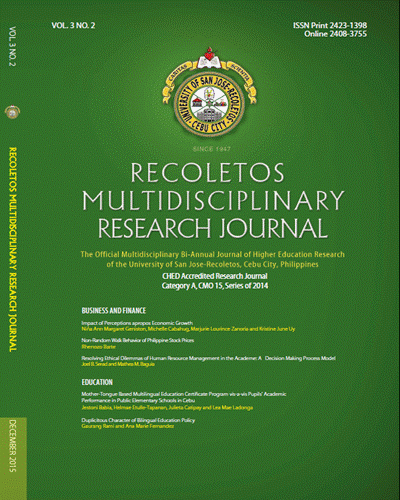Effectiveness of Custard Apple (Annona squamosa) Seed Extract in Treating Pediculosis Capitis
DOI:
https://doi.org/10.32871/rmrj1503.02.08Keywords:
Pediculosis capitis, Annona squamosa, permethrin, pediculicide, extractAbstract
Pediculosis capitis infestation, commonly known as head lice, a worldwide public health concern affecting individuals of all age groups, and prevalence in the general population can be as high as 40 percent. The main task attained in the study was the determination of the pediculicidal effects of Annona squamosa seed extract of different concentrations. Methodology utilized a true experimental design done in 3 trials; 10 live head lice were observed under each concentration of 25%, 50%, 75% atis seeds extract for the experimentation and 75% permethrin concentration as controlled group. In vitro testing was used and the subjects were placed in prepared petri dishes for experimentation. Data results found out that there is p-value of 0.067 at α = 0.05 for mean time elapsed (secs) for 100% head lice mortality. Significant p-level of 0.002 for pediculicidal activity for the first 5 minutes has been noted. The researchers derived up with a conclusion that Custard Apple (Annona squamosa) seed extract in 75%, 50% and 25% concentration is as effective as Commercial Pediculicide (Permethrin) in killing pediculosis Capitis. 50% concentration has comparable results to Permethrin and is the most effective due to its earlier onset of pediculicidal activity.
References
Dodd, C. S. (2006). Interventions for treating head lice (Review). Cochrane Database of Systematic Reviews, (4), CD001165. Retrieved from http://onlinelibrary.wiley.com/doi/10.1002/14651858.CD001165.pub2/epdf
Intaranongpai, J., Gritsanapan, W. & Chavasiri, W. (2006). Anti-head lice effect of Annona squamosa seeds. Southeast Asian Journal of Tropical Medicine Public Health, 37(3), 532- 535. Retrieved from http://www.tm.mahidol.ac.th/seameo/2006_37_3/16-3806.pdf
Kosalge, S. B. & Fursule, R. A. (2009). Investigation of licicidal activity of some plants from Satpuda Hills. International Journal of PharmTech Research, 1(3), 564-567. Retrieved from http://sphinxsai.com/ptvol3/pt=30,%20satish%20kosalge%20(564-567).pdf
Meinking, T. L, Entzel, P., Villar, M. E., Vicaria, M., Lemard, G. A. & Porcelain, S. L. (2000). Comparative efficacy of treatments for Pediculosis capitis infestations: Update 2000. Arch Dermatol, 137(3), 287-292. doi:10.1001/archderm.1986.01660150045013
Parvin, S., Islam, E., Rahman, M. & Haque, E. (2003). Toxicological evaluation of annotemoyin-1 isolated from Annona squamosa Linn.on on Long Evans rats. Pakistan Journal of Biological Science, 6(18), 1593-1596. Retrieved from http://docsdrive.com/pdfs/ansinet/pjbs/2003/1593-1596.pdf
Public Health Medicine Environmental Group. (2008). Head lice: Evidence-based guidelines based on the the Stafford Report 2008 Update. MeReC Bulletin, 18(5).
Tiangda, C. H., Gritsanapan, W., Sookvanichsilp, N. & Limchalearn, A. (2000). Anti-headlice activity of a preparation of Annona squamosa seed extract. Southeast Asian Journal of Tropical Medicine and Public Health, 31, 174-177.
Toynton, K., Luukinen, B., Buhl, K. & Stone, D. (2009). Permethirn technical fact sheet. Corvallis, OR: National Pesticide Information Center. Retrieved last March 23, 2013, from http://npic.orst.edu/factsheets/Permtech.pdf
Vander Stichele, R.H., Dezeure, E.M., & Bogaert, M.G. (1995). Systematic review of clinical efficacy of topical treatments for head lice. BJM, 311(7005), 604-8. doi: https://doi.org/10.1136/bmj.311.7005.604
Yagumyum, P. (2005). Efficacy of atis (Annona squamosa) as a pediculicide: An in vitro study. Philippine Scientific Journal, 38(1), 23-30.
Yapchiongco, R. (2010, April 5). Attack of the lice [Web log post]. Retrieved last February 16, 2013, from http://www.thepoc.net/thepoc-features/health-and-wellness/health-and-fitness-features/5648-how-to-deal-with-head-lice-nits-treatment-prevention.html
Downloads
Published
How to Cite
Issue
Section
License
Copyright of the Journal belongs to the University of San Jose-Recoletos


